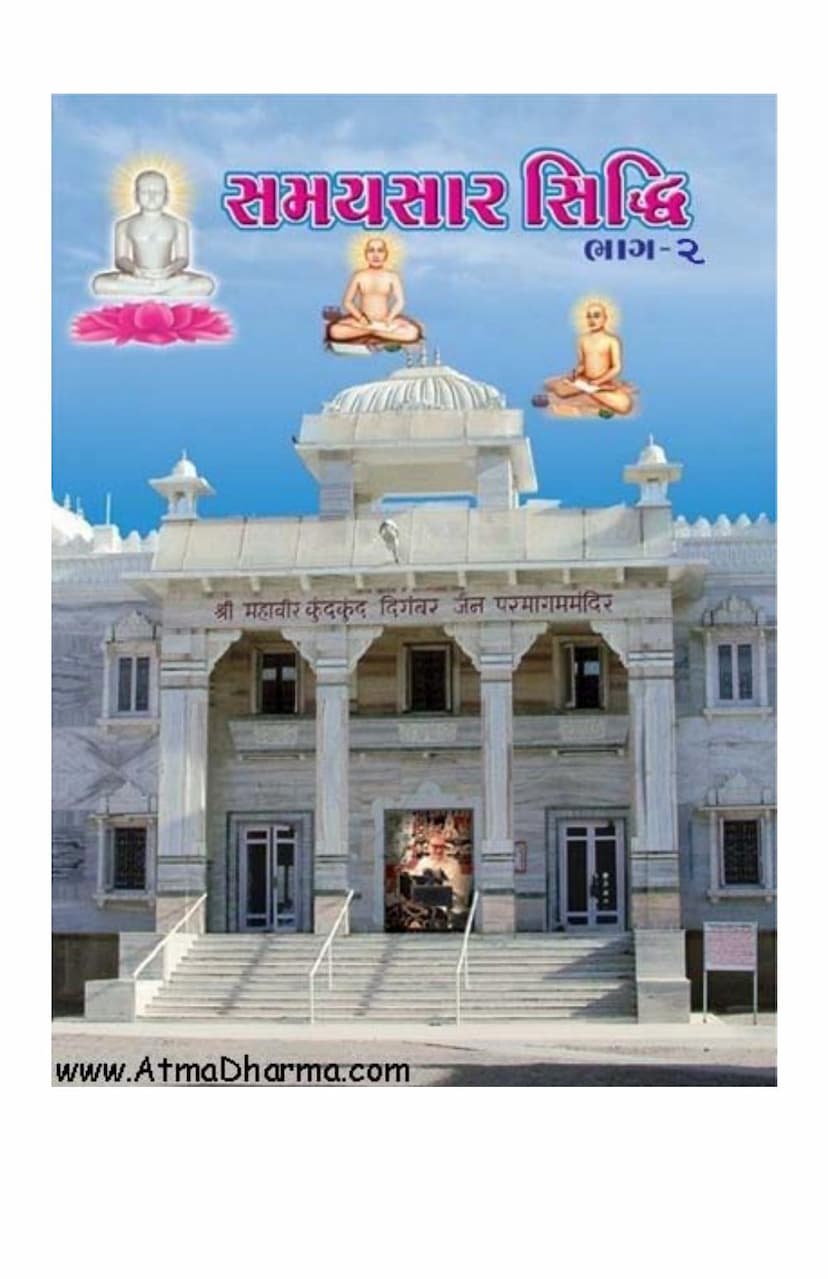Samaysara Siddhi 2
Added to library: September 2, 2025

Summary
This document is the Gujarati text for "Samaysara Siddhi Part 2," a commentary on Acharya Kundakunda's Samaysara by Pujya Gurudev Shri Kanji Swami. The provided text is a collection of discourses given by Kanji Swami on verses 13 to 38 of the Samaysara and their accompanying verses.
Here's a breakdown of the key themes and concepts discussed in the text, based on the provided pages:
Overall Purpose and Context:
- Commentary on Samaysara: The core purpose of this text is to explain the profound spiritual insights of Acharya Kundakunda's Samaysara, particularly focusing on the nature of the soul (Atma) and the path to liberation (Moksha).
- Discourses of Kanji Swami: The book is a compilation of lectures delivered by the revered Jain monk, Kanji Swami, who is considered an "Adhyatma Yugpurush" (a spiritual luminary of the era). His discourses are known for their clarity and ability to bring out the deep essence of Jain scriptures.
- Focus on Pure Soul (Shuddha Atma): The central theme is the realization of the pure, unadulterated soul, which is considered the true self and the key to liberation.
- Critique of External Practices: While not explicitly stated as a primary focus, the underlying message often contrasts the importance of internal realization with external religious rituals, suggesting that true spirituality lies within.
Key Jain Philosophical Concepts Discussed:
- Nayas (Perspectives): The text delves into the concept of "Nayas" (viewpoints or perspectives), particularly the distinction between:
- Nishchaya Naya (Ultimate Reality/Certainty Perspective): This perspective focuses on the eternal, unchanging nature of the soul, its inherent qualities of consciousness, bliss, and infinitude. It emphasizes the soul's separateness from all karmic and physical influences. The ultimate goal is to experience this pure, undifferentiated self.
- Vyavahara Naya (Conventional Reality/Practical Perspective): This perspective deals with the conventional ways of understanding and describing the soul, often using distinctions, classifications (like the nine tattvas - soul, non-soul, karma, bondage, etc.), and referring to the soul's interaction with the physical world and karma. While necessary for initial understanding, it's ultimately considered a means to reach the Nishchaya Naya.
- The Nature of the Soul: The soul is described as:
- Pure Consciousness (Chaitanya Swarupa): The soul is fundamentally pure consciousness, bliss, and knowledge.
- Eternal and Unchanging (Dhruv, Anant): It is eternal, unaffected by birth or death, and possesses infinite qualities.
- Separate from Karma and Body: The soul is distinct from karma, body, senses, thoughts, and all external manifestations.
- One but Manifested as Many: While the soul in its essence is one and indivisible, its manifestations (knowledge, perception, bliss, etc.) are its infinite qualities. The ultimate realization is of its oneness.
- "Abaddh" (Unbound): The soul, in its true nature, is not bound by karma or the physical realm. It is inherently free.
- Moksha (Liberation): Liberation is not achieved through external actions or rituals but through the direct realization and experience of the pure soul. The path involves understanding the soul's true nature, separating it from the non-soul, and abiding in that pure consciousness.
- The Role of Nayas: The text emphasizes understanding the distinction and ultimate reconciliation of Nayas. While Vyavahara Naya helps in initial understanding, it's the Nishchaya Naya that reveals the true nature of the soul and leads to liberation. The ultimate experience transcends all Nayas.
- The Importance of Self-Realization: The core message is that one must turn inward to realize the soul's true nature. External practices without this inner realization are considered insufficient.
- Critique of Worldly Attachments: The discourses implicitly or explicitly discourage attachment to worldly possessions, relationships, and actions (karma), as these are seen as obscuring the true nature of the soul.
- The Self as the Ultimate Truth: The ultimate truth and the object of meditation and realization is the soul itself, in its pure, unadulterated, and eternal state.
Structure of the Discourses (as suggested by the text):
- Verse-by-Verse Explanation: The discourses are presented verse by verse, with explanations of the Acharya's verses and the commentator's insights.
- Detailed Analysis: Kanji Swami breaks down complex philosophical points, using analogies and elaborations to make them accessible.
- Emphasis on Experience (Anubhuti): The ultimate goal is not mere intellectual understanding but direct experience of the soul.
Overall Tone:
- Devotional and Reverential: The text begins and ends with reverence for the divine and the spiritual masters.
- Didactic and Illuminating: The discourses aim to educate and enlighten the listener/reader about the path of spiritual liberation.
- Profound and Subtle: The concepts discussed are profound, requiring deep contemplation and sincere spiritual effort.
In essence, Samaysara Siddhi Part 2, through Kanji Swami's discourses, guides the seeker towards recognizing the soul as the pure, eternal, and liberated essence, distinct from all worldly conditions, and emphasizes the path of internal realization as the means to achieve ultimate freedom.